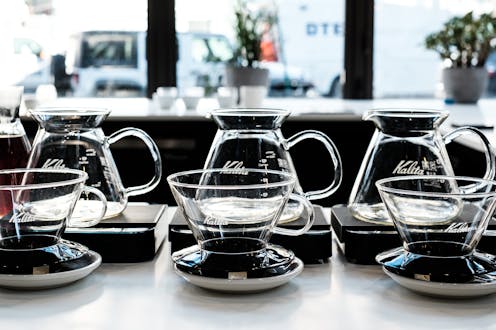
The craft revolution is everywhere: Craft beers, specialty coffee, handmade soaps and artisanal ice cream. While some may think this is foolish snobbery, others revel in the esthetics of craft experiences.
The craft revolution is often seen as a reaction against excessive industrialization or as a way to keep traditions and culture alive in the face of a homogenized, corporatized world. Instead of privileging the pursuit of profit, craft businesses and professionals are part of the rise of creative professions. They are driven by esthetic engagement, creative expression and an aspiration for quality.
Craft work gives professionals the opportunity to create unique products that align with their personal visions. This helps the makers distinguish themselves and express their identity through their work.
Craft brings forth the growing desire of producers and professionals for esthetic engagement, creative expression and aspiration for quality. The coffee market offers us an array of cultural resources and expressions, such as “handcrafted,” “connoisseur,” “artisanal” and “coffee snob.”
Making a market
The values and beliefs behind craft work and esthetic engagement, creativity and quality have seeped into many markets, including those for barbering, beer, butchering, chocolate, cocktails, tattoos, cuisine, denim, fashion, motorcycles and coffee.
Between 1991 and 1998, the number of specialty coffee shops in the United States grew to about 10,000 from 1,650. By 2015, there were 31,490 specialty shops. Specialty coffee is now more than half of the $48 billion retail value of the U.S. market.
This rise in demand and popularity of a craft-oriented approach to a consumer good has shifted a large part of the market towards craft values and beliefs.
Read more: How the third wave of coffee shops is transforming high streets
Values and beliefs
Businesses conduct their activities based on key values and beliefs. Craft firms undertake theirs striving for esthetic engagement, creative expression and an aspiration to quality. In contrast, commercial firms such as McDonald’s McCafé and Tim Horton’s privilege the maximization of profits.
Consequently, each type of business — commercial or craft — innovates in different ways. In coffee, craft business have pushed toward ways of farming, processing, roasting and brewing coffee to bring out the distinctive flavors of specific coffee beans associated with their origin, terroir (how the circumstances of its growth affects its taste) and varieties.

Innovative products, such as the Kruve coffee sifter, the Decent DE1+ espresso machine or the Weber EG-1 coffee grinder, all share the same key characteristic: to offer baristas and consumers more control over coffee-making variables so that they can perfect the coffee’s esthetic experience.
Commercial firms introduce products that have profit potential. The infamous Starbucks’ Pumpkin Spice Latte, the Nespresso Vertuo and Tim Horton’s recently launched line of espresso-based drinks are not concerned with the coffee experience or bringing out the distinctive flavors of a bean. Rather, they offer consumers fun, affordable or convenient products and services that help increase firms’ profit margins.
Crafting language
Whatever the values and beliefs of craft or commercial businesses, it is the interactions between them that push markets such as the one for coffee to become more craft-like. Commercial firms take inspiration from craft businesses’ desire for esthetic engagement and creativity.
They borrow from the vocabulary that craft firms brought to the coffee market, such as Dunkin’ Donuts’ “Handcrafted” coffee drinks or Nespresso’s coffee pods “inspired by” Brooklyn’s and Melbourne’s baristas.
They automate the complicated and ritualistic coffee-making processes of craft baristas, increasing profitability but also introducing everyday consumers to some aspects of craft coffee-making.
Craft companies esthetically engage with commercial innovation. They transform the Pumpkin Spice Latte by using artisan syrup and curated spices that ideally match the taste characteristics of a specific coffee bean. Some craft companies have also leveraged the convenience offered by pod machines and developed their own versions to provide consumers with the opportunity to experience high-end coffee at home.
Over time, these interactions evolve the market as a whole, bringing in craft values and transforming the experience of all consumers.
Engagement, expression and authenticity
The complexities associated with craft products have also allowed people to develop and distinguish themselves through their tastes. Cultural resources and expertise are key in how we express ourselves and define who we are.
The craft revolution has supported the professionalization of many fields. Professions such as barber, butcher, barista and mixologist are now infused with elevated cultural cachet. It has also supported the emergence of new identities, from coffee connoisseurs to bearded villains to cocktail nerds.
Some have argued that craft offers more authentic products, perhaps because craft work creates a kind of one-to-one relationship between the producer and consumer that is different from the standardized mass market production that dominates so much of our economy. But while craftspeople’s creative expression might be found in their products and presentation, commercial firms have become skilled at mimicking the artistry of craft professionals, making it difficult to identify which is which.
Authenticity is an ambiguous concept — what one might find authentic might be seen as elitist by others. Perhaps the success of craft might lie in its capacity to tap into our nostalgic ideals of work and our increasing desires for connection with the origins of products and the stories and people behind them.
Pierre-Yann Dolbec receives funding from Concordia University and the Social Sciences and Humanities Research Council.
This article was originally published on The Conversation. Read the original article.







